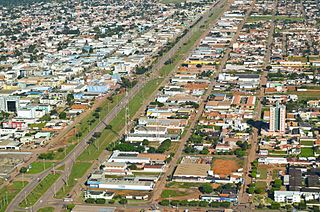This page is based on this
Wikipedia article Text is available under the
CC BY-SA 4.0 license; additional terms may apply.
Images, videos and audio are available under their respective licenses.

Tupiniquim are an indigenous people of Brazil, who now live in three indigenous territories. The indigenous territories are located near the cities of Santa Cruz and Vila do Riacho in the municipality of Aracruz in northern Espírito Santo state, southeastern Brazil. Caieiras Velhas Indigenous Territory is located along the banks of the Piraquê-Açu River. The Pau-Brasil Indigenous Territory is near the Sahy creek. The Comboios Indigenous Territory is located on the banks of the Comboios River. A 2010 census determined the population of Tupiniquim in all three indigenous territories as 2,630.
The Akuntsu are an indigenous people of Rondônia, Brazil. Their land is part of the Rio Omerê Indigenous Territory, a small indigenous territory which is also inhabited by a group of Kanoê. The Akuntsu were victims of a massacre perpetrated by Brazilian cattle ranchers in the 1980s and currently number just four individuals.
The Aparai or Apalai are an indigenous people of Brazil, who live in Amapá and Pará states. A little community is located in French Guiana, in Antecume Pata. They were sedentary slash-and-burn farmers, necessitating periodic relocation as soil became exhausted, but also hunters and gatherers. They spoke a Carib language and in the 20th century their subsistence shifted towards craftwork as they adapted to modern Brazil and the cash economy.
The Trumai are an indigenous people of Brazil. They currently reside within the Xingu National Park, in the state of Mato Grosso. They have a population of 258 in 2014. They were 97 in 2011 and 120 in 2006, up from a low of 26 in 1966.
The Kanoê are an indigenous people of southern Rondônia, Brazil, near the Bolivian border. There are two major groups of Kanoê: one residing in the region of the Guaporé River and another in the Rio Omerê Indigenous Territory. The latter consists of just five individuals following violent contact with white settlers in the last few decades. The Kanoê of the Guaporé River have also had a troubled history of interaction with colonists; significantly reduced in population, they are now largely assimilated into neighbouring indigenous and non-indigenous peoples.
The Kwazá are an indigenous people of Brazil. Most Kwazá live with the Aikanã and Latundê in the Tubarão-Latundê Indigenous Reserve in the province of Rondônia; however, some Kwazá live in the Terra Indígena Kwazá do Rio São Pedro. In 2008 their population was 40, up from 25 in 1998.

The Guajajara are an indigenous people in the Brazilian state of Maranhão. They are the most numerous indigenous group in Brazil.
The Yudjá are an Indigenous people of Brazil, who live in the states of Mato Grosso and Pará. They live in two villages in the Xingu Indigenous Park, located near the mouth of the Maritsauá-Mitau River. They fish and raise crops, such as manioc.
The Matipu people are an indigenous people of Brazil. They live in the southern part of the Xingu Indigenous Park in the state of Mato Grosso. Their a population is estimated at about 149 individuals in 2011, up from population of 40 in the 1995 census. They are mainly of animist faith and share many cultural traits with other Xingu peoples.

In Brazil, an indigenous territory or indigenous land is an area inhabited and exclusively possessed by indigenous people. The Brazilian Constitution recognises the inalienable right of indigenous peoples to lands they "traditionally occupy" and automatically confers them permanent possession of these lands. In practice, however, a formal process of demarcation is required for a TI to gain full protection, and this has often entailed protracted legal battles. Even after demarcation, they are frequently subject to illegal invasions by settlers and mining and logging companies.
The Uru-Eu-Wau-Wau are an indigenous people of Brazil, living in the state of Rondônia.
The Arara people, also called Arara do Pará are an indigenous people of Brazil, living in the state of Pará, Brazil. They are known for both their prowess in warfare and trophy-keeping practices, as well as their ability to interact and accommodate non-native peoples. They maintained a nomadic existence and frequently intermarried with other tribes. The largest Arara settlement is Laranjal village.
The Zuruahã are an indigenous people of Brazil, living along the Purus River in the state of Amazonas.
The Tembé, also Timbé and Tenetehara, are an indigenous people of Brazil, living along the Maranhão and Gurupi Rivers, in the state of Amazonas and Pará. Their lands have been encroached and settled by farmers and loggers, who do so illegally, and the Tembé are working to expel the intruders from their territories.
The Latundê, also known as the Leitodu, are an indigenous peoples of Brazil. They live in the Aikaná-Latundê Indigenous Reserve in the southern Rondônia in the southwestern Amazon. They share the indigenous territory with the Kwaza and Aikanã people. Together the three tribes founded the Massaká Association of the Aikanã, Latundê and Kuazá Indigenous Peoples in 1996 to protect their rights.
The Machinere are an indigenous people of Brazil, Bolivia, and Peru. They live along the Acre River in Bolivia. In Brazil they mostly live in the Mamoadate Indigenous Territory, although some live in the Chico Mendes Extractivist Reserve, both in Acre.

The Atikum, also known as Huamuê or Uamué, are an indigenous people of Brazil that live in Bahia and Pernambuco.








